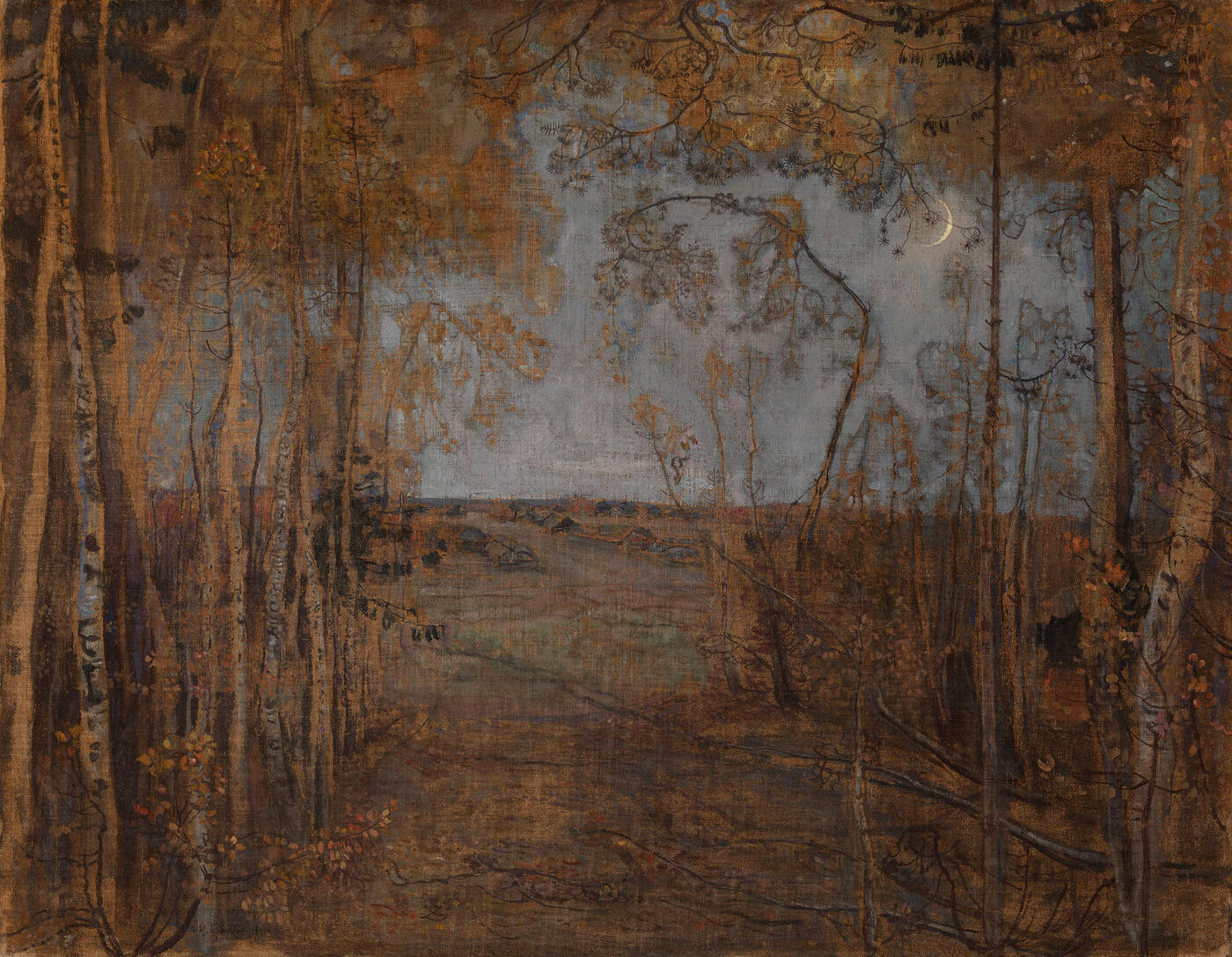MacDougall's Russian Art Auctions 27-30 May 2012
27 May 2012

* 1. BRODSKY, ISAAK (1884-1939)
New Moon, signed and dated 1912.
Oil on canvas, 62 by 80 cm.
250,000–400,000 GBP
Provenance: Collection of E.I. Brodsky, the artist’s son, Leningrad.
Private collection, St Petersburg.
Private collection, Europe.
Authenticity of the work has been confirmed by the expert V. Kruglov.
Exhibited: Isaak Israilevich Brodsky. Vystavka proizvedenii. K 90-letiyu so dnya rozhdeniya, Museum of the Academy of Arts, Leningrad, 1974.
Isaak Israilevich Brodsky. Vystavka k 100-letiyu so dnya rozhdeniya, Museum of the Academy of Arts, Leningrad, 1984.
Literature: I.I. Brodsky, Sbornik statei, Leningrad, Izdanie yubileinogo komiteta, 1929, illustrated in black and white.
Isaak Israilevich Brodsky. Stat’i, pis’ma, dokumenty, Moscow, Sovetskii khudozhnik, 1956, p. 179, listed under works from 1912.
Exhibition catalogue, Isaak Israilevich Brodsky. Katalog vystavki proizvedenii. K 90-letiyu so dnya rozhdeniya, Leningrad, Iskusstvo, 1974, p. 32, listed.
Exhibition catalogue, Isaak Israilevich Brodsky. Vystavka k 100-letiyu so dnya rozhdeniya, Leningrad, Iskusstvo, 1984, p. 42, listed.
Isaak Brodsky painted New Moon soon after returning from his travels round Spain, France and Italy, and the painting has noticeable signs of the romanticised approach to nature which is characteristic of the artist’s work in the 1910s. The attraction of this painting is a poetry that tugs at the heartstrings and its lyrical image of evening. It is a work of symbolism, but at the same time it retains a sense of naturalism in its vision of nature.
The moon is a pale sickle, the branches of the trees glint, and a softly diffused light shines on the ground. The generally subdued palette
of this landscape and the delicate relationships between the cold and the slightly warmer blue-grey tones, with no sharp contrast between dark and light, create the feeling of a sonorous and transparently clear dewy autumn evening. The painting comprises several layers: against the delicate blue-grey background the foliage is painted in patches of Umber and Sienna and later the twigs are touched in with a fine round brush to add expressive detail. Brodsky made the transition from a relatively fluid, Italian use of paint to a slightly fuller-bodied technique on a “thinned out” background.
In his recollections Arkadiy Rylov gives a very exact description of the artist’s landscape technique: “Brodsky – like a jeweller or a weaver – covers his landscapes in patterns... These colourful patterns are original and lovely. He does not paint, but rather he draws with a fine paintbrush”.
In fact, among the various means of expression employed in New Moon it is drawing that plays the leading role. Everything is subordinated to a stylising delineation. It is easy to discern strong admiration for the creative alignment of two associations – the Union of Russian Artists and World of Art. The conventionality of the painting’s rendition and the accentuated decorativeness of the composition are reminiscent of a theatrical backcloth created by the brush of a virtuoso artist and glimpsed, as it were, through the branches of the wings and scenery borders.
It is surprising that Brodsky never turned his hand to theatre design. It is hard to find landscapes more theatrically constructed than his.
The tree canopies and branches in the wings guide the eye into the open space of the landscape, allowing the focus to fall on the delicate, fragile beauty of nature lapsing into sleep and the barely discernible village floating in the distance. The view through branches into a landscape’s depth was one of the artist’s favourite and oft-repeated devices: indeed, one of Brodsky’s paintings from the 1910s was called Through the Branches.
A contemporary of Brodsky’s, the renowned painter Konstantin Yuon, recalled:
“I always understood his landscapes as pieces of music, the fine violin part led
by his drawing, ever melodious”. And the artist himself, giving rein to his
thoughts at the time, wrote: “My favourite motifs have remained, as before,
landscapes seen in breadth, with wide open spaces and a perspective receding
into their depths. I have been striving to construct landscape as a compositional
entity, as a picture, intuitively resisting preoccupation with landscape sketched
from nature, as inspired by Impressionism, which the imitators of that school elevated to a value sufficient in itself, driving out the idea of composing large creative works of art”.
During the period when New Moon was painted, and right up until the Revolution, the vast majority of critics described Brodsky primarily as a landscape painter, which was partly due to his exceptional productivity in this genre.
Notes on symbols:
* Indicates 5% Import Duty Charge applies.
Ω Indicates 20% Import Duty Charge applies.
§ Indicates Artist's Resale Right applies.
† Indicates Standard VAT scheme applies, and the rate of 20% VAT will be charged on both hammer price and premium.